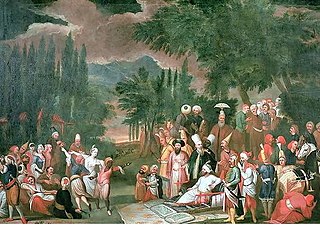
Kul Tigin was a general and a prince of the Second Turkic Khaganate.

The Ili River is a river situated in Northwestern China and Southeastern Kazakhstan. It flows from the Ili Kazakh Autonomous Prefecture of the Xinjiang Uighur Autonomous Region to the Almaty Region in Kazakhstan.
Esegels were a dynastic tribe, of Turkic linguistic affiliation, in the Middle Ages who either joined the Itil Bulgaria state and were assimilated to Bulgars.

The Western Turkic Khaganate or Onoq Khaganate was a Turkic khaganate in Eurasia, formed as a result of the wars in the beginning of the 7th century after the split of the Turkic Khaganate into a western and an eastern Khaganate.

Yueban, colloquially: "Weak Xiongnu", was the name used by Chinese historians for remnants of the Northern Xiongnu in Zhetysu, now part of modern-day Kazakhstan. In Chinese literature they commonly called Yueban. The Yuebans gained their own visibility after disintegration of the Northern Xiongnu state, because unlike the main body of the Northern Xiongnu, who escaped from the Chinese sphere of knowledge, the Yueban tribes remained closer to China.
Ishbara Khagan was the last khagan of the Western Turkic Khaganate.

The Türgesh, Turgish or Türgish were a Turkic tribal confederation. Once belonging to the Duolu wing of the Western Turkic On Oq elites, Turgshes emerged as an independent power after the demise of the Western Turks and established a khaganate in 699. The Turgesh Khaganate lasted until 766 when the Karluks defeated them. Turgesh and Göktürks were related through marriage.

The Xueyantuo tribe were an ancient Tiele Turkic people and khaganate in central/northern Asia who were at one point vassals of the Göktürks, later aligning with China's Tang Dynasty against the Eastern Göktürks.
Yabghu or Yabgu was a state office in the early Turkic states, roughly equivalent to viceroy. The title carried autonomy in different degrees, and its links with the central authority of Khagan varied from economical and political subordination to superficial political deference. The title had also been borne by Turkic princes in the upper Oxus region in post-Hephthalite times.
The Chigil were a Turkic tribe known from the 7th century CE as living around Issyk Kul lake area. They were considered to be descended from two Yueban tribes: Chuyue and Chumi.
The Yagmas, or Yaghmas, were a medieval tribe of Turkic people that came to the forefront of history after the disintegration of the Western Turkic Kaganate. They were one component of a confederation which consisted of Yagma, the Karluks, the Chigils and other tribes which founded the Kara-Khanid Khanate. From the seventh century until the Karakhanid period, the Yagma were recorded in Arabic, Persian, and Chinese accounts as a prominent and powerful political entity in the Tarim Basin, Dzungaria, and Jeti-su.
Shad was a state office in the early Central Asian Turkic states, roughly equivalent to governor. "Shad" could only be an appointee over a vassal tribe, where he represented interests of the preeminent Kagan. The name of this tribe was included in his title. For example, Tardu-shad could only be a Shad over Tardu tribe. The title carried autonomy in different degrees, and its links with the central authority of kagan varied from economical and political subordination to superficial political deference. The title Shad is borrowed from an Iranian source.
The Basmyls were a 7th- to 8th-century nomadic tribe who mostly inhabited the Dzungaria region in the northwest of modern-day China.
Yuri Alexeyevich Zuev or Zuyev was a Russian-born Kazakh sinologist and turkologist.
Nushibi was a Chinese collective name for five tribes of the right (western) wing in the Western Turkic Khaganate, and members of "ten arrows" confederation found in the Chinese literature. The references to Nushibi appeared in Chinese sources in 651 and disappeared after 766. The Nushibi tribes occupied the lands of the Western Turkic Kaganate west of the Ili River of contemporary Kazakhstan.
Yukuk Shad reigned in the final days of the Western Turkic Khaganate. His name Yukuk means "owl", according to Gumiloyv, or means "venerable", according to Gabain. His full title was 乙毗咄陆可汗 Yipi Duolu Kehan
Sy Yabghu Qaghan was a khagan in the Western Turkic Khaganate between 631–633 or 630–632. His full title was Yǐpí (shā)bōluō sì yèhù kèhán 乙毗(沙)钵罗肆叶护可汗 ; personal name: Ashina Xili 阿史那咥力
Duolu Qaghan was a ruler of the Western Turkic Khaganate during 632–634 or 633–634.
Ishbara Tolis was the ruler of Western Turkic Khaganate (empire) between 634–639. His full title was Shābōluō xìlìshī (~diélìshī) kèhán 沙钵罗咥利失可汗, personal name Ashina Tong-e 阿史那同俄).

Duolu was a tribal confederation in the Western Turkic Khaganate. The Turgesh Khaganate (699-766) may have been founded by Duolu remnants.





